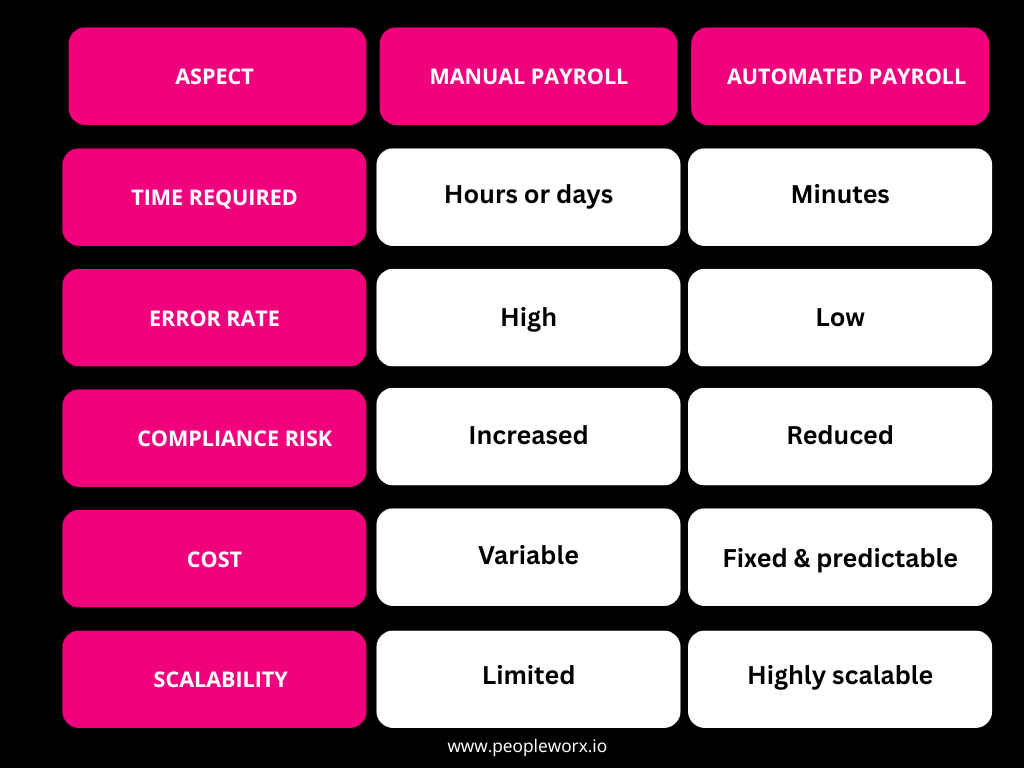Managing payroll is a critical yet complex function for small businesses, especially construction business. Managing payroll in the construction industry is no small feat. Between fluctuating job sites, seasonal labor, and ever-changing compliance requirements, small construction businesses often find themselves spending more time in the back office than on the job site. These challenges can lead to inconsistencies and inefficiencies, impacting overall profitability and growth. The solution for many is migration to an automated payroll system.
Content
- What is an Automated Payroll System?
- Case Study: Streamlining Payroll for a Small Construction Business
- Key Components of an Automated Payroll System
- How do Automated payroll Systems Work?
- Key benefits of Automated Payroll Systems
- Enhanced Accuracy & Compliance
- Cost Saving & Scalability
- Manual Payroll vs. Automated Payroll
- Choosing the Right Payroll System for Your Small Business
- The Future of Automated Payroll Solution
What is an Automated Payroll System?
An automated payroll system is a technology-driven solution that simplifies and digitizes payroll processing. Instead of manually calculating wages, deductions, and tax withholdings, these systems automate the process using pre-set parameters, ensuring accuracy, compliance, and efficiency.
For businesses operating with limited HR staff or those subject to strict labor laws, an automated system can mitigate risks while freeing up time for strategic workforce management.
Case Study: How a Small Construction Company Cut Payroll Processing Time by 85% with PeopleWorX
This case study highlights how one construction company overcame those payroll challenges by implementing PeopleWorX’s automated payroll solution—and saw measurable, immediate results.
The Challenge: Payroll That Consumed an Entire Workday
A small, family-owned construction company faced a common but significant operational bottleneck: manually processing payroll. With a workforce composed of both full-time staff and seasonal laborers, their in-house process took more than eight hours every payroll cycle.
Key issues included:
- Excessive administrative time spent every pay period
- IRS fines due to payroll tax miscalculations
- Disorganized and repetitive onboarding for seasonal workers
These inefficiencies didn’t just affect the payroll department—they disrupted project timelines, strained internal resources, and created compliance risks.
The Solution: Automating Payroll with PeopleWorX
The business partnered with PeopleWorX, a workforce management provider specializing in small and mid-sized businesses, to modernize their payroll operations. By transitioning from manual processing to an automated payroll system, they streamlined their workflow, improved accuracy, and regained valuable time.
The Results: Efficiency, Compliance, and Control
The impact of the change was immediate and measurable:
- Payroll processing time reduced by 85%, allowing the team to focus on core operations
- Tax compliance was brought up to date, eliminating costly IRS penalties
- Seasonal worker onboarding became seamless, improving hiring experiences and reducing delays
Why It Matters
In the construction industry, efficiency drives profitability. An outdated payroll system can silently drain time, increase compliance risk, and hinder business growth. This company’s experience is a clear example of how the right technology partner can transform payroll from a burden into a business advantage.

Key Components of an Automated Payroll System
Most payroll systems integrate several core functions to ensure seamless payroll management:
- Time and Attendance Tracking: Syncs with timekeeping tools (e.g., biometric scanners, and online timesheets) to calculate hours worked.
- Automatic Salary Calculation: Computes gross pay based on hourly wages, salaried contracts, and overtime rules.
- Tax Withholding & Compliance: Applies deductions based on federal, state, and local tax regulations, updating rates as laws change.
- Direct Deposit Processing: Automates salary payments via bank transfers, reducing reliance on paper checks.
- Employee Self-Service Portals: Provides employees with online access to pay stubs, W-2s, and tax documents.
- Benefits and Deductions Management: Calculates health insurance, retirement contributions, and other employee deductions.
- Reporting & Analytics: Generates reports for audits, financial planning, and tax compliance.
How Do Automated Payroll Systems Work?
Automated payroll systems function by integrating various data points to calculate and process employee compensation seamlessly. Here’s an overview of the workflow:
-
- Data Collection: Employee hours, salary details, and benefits information are gathered from integrated systems (e.g., Point of Sale systems).
- Payroll Calculation: The system determines gross pay, applies deductions for taxes, benefits, and other withholdings, and calculates net pay.
- Tax Compliance Processing: The system applies current tax regulations, ensuring accurate withholdings and reducing compliance risks.
- Salary Distribution: Payments are processed via direct deposit, payroll cards, or printed checks.
- Reporting & Recordkeeping: The system generates reports for accounting, audits, and tax filings, maintaining necessary payroll records.
Key Benefits of Automated Payroll Systems
Increased Efficiency & Time Savings
Payroll processing that once took hours or even days can now be completed in minutes. Automated systems:
-
-
- Handle tax calculations and withholdings instantly.
- Generate pay stubs and tax forms without manual input.
-
- Ensure seamless direct deposit processing for all employees.
-
Enhanced Accuracy & Compliance
Manual payroll processing carries a high risk of calculation errors that can lead to underpayments, overpayments, or compliance violations. An automated system helps by:
-
-
- Applying real-time tax updates to ensure payroll compliance.
- Flagging inconsistencies before payroll is processed.
-
- Generating audit-ready reports to simplify tax filing.
-
Cost Saving & Scalability
While an initial investment is required, the long-term cost savings are significant. Businesses can:
- Reduce the need for additional HR staff.
- Avoid costly penalties for payroll miscalculations.
- Scale efficiently as the workforce grows without increasing administrative burdens
Manual Payroll vs. Automated Payroll: A Comparative Analysis

For businesses looking to enhance payroll accuracy, ensure compliance, and save time, transitioning from manual to automated payroll is a logical step.
Choosing the Right Payroll System for Your Small Business
When evaluating payroll solutions, consider:
- Integration Capabilities: Syncing with time-tracking, benefits, and accounting software.
- Scalability: Adapting to business growth and multi-state tax compliance.
- Ease of Use: Intuitive platforms for HR teams and employees.
- Tax Compliance Features: Automatic federal, state, and local tax rate updates.
- Security & Data Protection: Safeguarding payroll data from fraud and breaches.
The Future of Automated Payroll Solutions is Workforce Management
As businesses adapt to an evolving workforce landscape, payroll automation is no longer a luxury, it’s a cost of doing business. When selecting an automated payroll system for your small business, it’s crucial to consider solutions that not only streamline payroll processes but also enhance overall workforce management solutions.
PeopleWorX helps small businesses with everything from payroll to workforce management strategies. Our team has deep expertise in payroll and HR. We aim to stay current with the constantly evolving legal and regulatory landscape to ensure your company remains compliant. Our workforce solutions encompass all aspects of employee lifecycle management, from initial hiring to retirement. We offer customized assistance designed to address the specific requirements of your organization.






